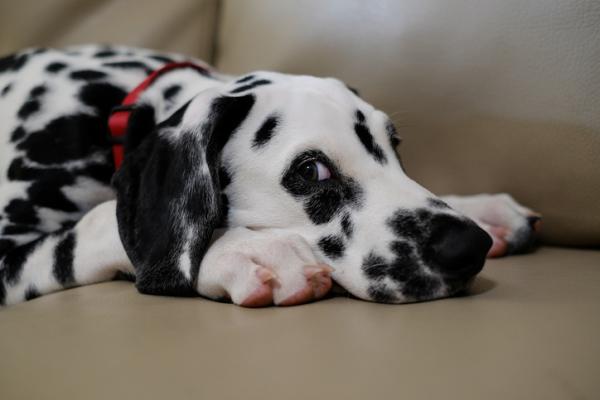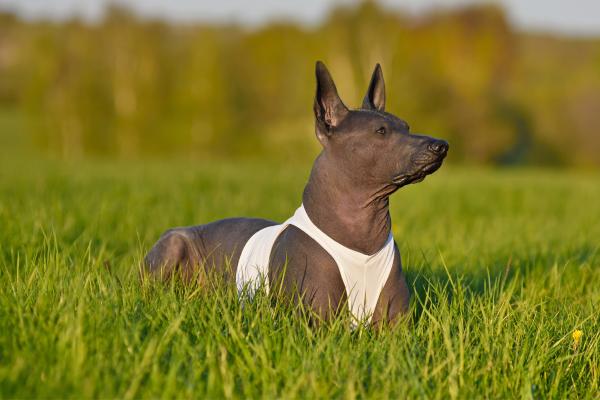Dog Coat Types and Grooming



See files for Dogs
Dogs, originally descended from wolves, have been selectively bred for various roles throughout history, resulting in a remarkable diversity of breeds adapted to different environments. This wide range of coat types is influenced by numerous genes, contributing to the incredible variety of breeds we see today. Proper grooming is crucial not only for maintaining the coat's appearance, but also for ensuring a dog’s overall health and well-being.
In the upcoming AnimalWised article, we will explore various dog coat types and grooming techniques, offering valuable tips to keep your dog's fur healthy and looking its best.
Short hair
Dogs with short hair have a smooth, shiny coat that lies flat against their skin. This type of fur is easy to care for because it doesn’t require a lot of brushing or grooming. It’s also good for different types of weather, making these dogs adaptable to various climates.
Some popular breeds with short hair include Beagles, Boxers, and Dalmatians.
How to take care of a short-haired dog?
- Brushing: a weekly brushing session is typically adequate to eliminate loose hairs and maintain a lustrous coat. Employ a brush specifically designed for short hair, such as a slicker brush or a rubber curry brush.
- Bathing: Bathing every 4-6 weeks, or as required, using a gentle dog shampoo formulated for short hair, helps to keep the coat clean and healthy. Avoid over-bathing, as excessive washing can strip natural oils from the skin.
Incorporate a rubber curry brush or a grooming glove into your grooming routine to stimulate the skin and promote the distribution of natural oils. This practice can enhance the overall health and appearance of your dog's coat. Additionally, consider using a leave-in conditioner after bathing to provide extra moisture and shine.

Medium hair
Medium-haired dogs have coats that are a bit longer than short-haired dogs, giving them a fluffier and thicker appearance. This type of coat helps protect them from both cold and hot weather. However, because of the extra length, their fur can get tangled and matted more easily, especially around the chest, belly, and behind the ears.
Breeds such as Golden Retrievers and Border Collies often feature medium-length coats.
How to take care of a medium-haired dog?
- Brushing: To prevent matting and tangles, brush your medium-haired dog's coat 2-3 times per week. A slicker brush or pin brush is effective for removing loose hairs and maintaining a smooth coat.
- Bathing: Bathing every 6-8 weeks is generally recommended, but adjust the frequency based on your dog's activity level and the specific needs of their coat. For instance, dogs that frequently engage in muddy or dirty activities may require more frequent bathing.
If your dog's coat tends to become matted, consider using a detangling spray before brushing to make the process easier and less uncomfortable. Additionally, ensure that you dry your dog's coat thoroughly after bathing to prevent moisture-related issues.

Long hair
Long-haired breeds, like Shih Tzus and Afghan Hounds, have coats that require more attention and care than dogs with shorter hair. Their fur can grow several inches long, making it more prone to tangling and matting if not properly maintained. Without consistent care, their long hair can become tangled, which can be uncomfortable for the dog and more difficult to manage.
Long-haired dogs may also need special attention to areas like their ears, belly, and legs, where tangles are more likely to form.
Popular long-haired breeds include Shih Tzus and Afghan Hounds, known for their luxurious coats that can grow several inches in length.
How to take care of a long-haired dog?
- Brushing: daily brushing is crucial to prevent matting and maintain a healthy coat. Utilize a combination of a pin brush and a comb to effectively reach through the entire length of the hair. Pay particular attention to areas prone to matting, such as behind the ears and beneath the legs.
- Bathing: bathe long-haired dogs every 4-6 weeks, employing a conditioner to keep the hair soft and manageable. Avoid over-bathing, as excessive washing can strip natural oils from the coat.
If your dog's coat becomes heavily matted, professional grooming may be necessary to detangle the hair without causing discomfort. Consider using a leave-in conditioner after bathing to provide extra moisture and protection.
Additionally, regular trimming can help to manage the length of the coat and reduce the likelihood of matting.
Dive deeper into the world of grooming with our tips for maintaining stunning, long-haired breeds.

Curly hair
Curly-haired dogs have dense, textured coats that can easily become matted without proper care. While their curls can be stunning, they need regular grooming to keep them looking their best and to prevent tangles.
The curliness of a dog's coat is determined by the shape of the hair shaft and how it grows from the follicle. Dogs with curly hair typically have oval-shaped hair follicles, which produce hair that twists as it grows. In contrast, dogs with straight hair have round follicles.
It is believed that curly hair is water-resistant, which is advantageous for dogs that are bred for activities involving water, like retrieving game from lakes or rivers.
Popular long-haired breeds include Poodles and Bichon Frises.
How to take care of a curled-haired dog?
- Brushing: daily brushing is essential to prevent tangles and mats. Use a slicker brush and a comb to carefully work through the curls. Pay special attention to areas prone to matting, such as behind the ears and under the legs.
- Bathing: bathe curly-haired dogs every 4-6 weeks using a moisturizing shampoo to keep the curls soft and bouncy. Avoid over-bathing, as excessive washing can strip natural oils from the coat.
Regular trims are often necessary to maintain the coat's shape and prevent matting. Consider using a leave-in conditioner after bathing to provide extra moisture and protection.

Wire hair
This coat type is characterized by its coarse texture, which serves several important functions. The wire-haired coat is designed to provide robust protection against harsh environmental elements, including cold, rain, and rough vegetation. The wiry texture of the fur helps to repel water and debris, keeping the dog dry and comfortable in challenging conditions.
Additionally, the coarse hair can help shield the dog from bites and scratches while traversing through dense underbrush or rugged terrain.
Breeds such as the Jack Russell Terrier and the Scottish Terrier are prime examples of dogs with wire-haired coats.
How to take care of a wire-haired dog?
- Brushing: weekly brushing with a slicker brush assists in removing dead hair and maintaining the coat's appearance.
- Bathing: bathing every 4-6 weeks is generally adequate, but avoid excessive bathing, as it can soften the coarse texture of the coat.
Hand-stripping is often recommended to preserve the wiry texture of the coat. This involves manually removing dead hairs rather than using a clipper. Hand-stripping can be a specialized skill and may require professional assistance.
Additionally, consider using a dog-specific shampoo formulated for wire-haired coats. Wire hair can trap dirt and debris more easily than other coat types. Wire-haired shampoos are formulated to penetrate deep into the coat, effectively removing dirt and grime without stripping away natural oils.
Want to give your dog's coat an extra shine? Discover simple tricks and tips to make your furry friend's fur gleam in our next article.

Double-coated breeds have a unique fur structure designed for protection and insulation.
Their coats consist of two distinct layers: a dense, soft undercoat and a longer, coarser outer coat. The undercoat acts as insulation, trapping air close to the skin to keep the dog warm in cold weather. Meanwhile, the outer coat, which is more resistant to water and dirt, provides a barrier against harsh elements like rain, snow, and wind.
This dual-layer system helps regulate the dog’s body temperature and keeps them comfortable in extreme conditions.
Popular breeds with this type of coat are Huskies and German Shepherds,
How to take care of a double-coated dog?
- Brushing: brush your double-coated dog's coat 2-3 times per week, increasing the frequency during shedding seasons (spring and fall) to effectively manage the undercoat. A slicker brush and an undercoat rake or de-shedding tool are helpful for removing loose hairs and preventing matting.
- Bathing: bathe your double-coated dog every 6-8 weeks, ensuring to dry the coat thoroughly to prevent moisture-related issues and matting. Avoid over-bathing, as excessive washing can strip natural oils from the coat.
Use an undercoat rake or de-shedding tool to reach the dense undercoat and remove loose hairs efficiently. Avoid shaving double-coated dogs, as this can negatively impact their coat's natural insulating properties. Additionally, consider using a leave-in conditioner after bathing to provide extra moisture and protection.
Ever wondered about the impact of dyeing your dog's hair? Find out why it's best to avoid it in our upcoming article.

Hairless
Hairless breeds are known for their lack of a traditional fur coat. Instead of hair, these dogs have mostly exposed skin that requires specific care.
Their skin can be prone to dryness, sunburn, and irritation, so regular moisturizing and sunscreen application are often needed. Additionally, they may need to be protected from extreme temperatures, as they lack the natural insulation provided by fur.
Despite their unique appearance, hairless breeds are often cherished for their distinctive look and hypoallergenic qualities.
Breeds such as the Chinese Crested and the Xoloitzcuintli are prime examples of hairless dogs.
How to take care of a hairless dog?
- Brushing: use a soft cloth or grooming glove to gently wipe down your hairless dog's skin on a regular basis. This helps to remove dirt and dead skin cells.
- Bathing: bathe your hairless dog every 2-4 weeks to keep the skin clean and healthy. Employ a mild shampoo formulated for sensitive skin to avoid irritation.
Apply a dog-safe moisturizer or sunscreen to protect the skin, particularly during sunny or cold weather. This helps to prevent sunburn, dryness, and other skin issues. Additionally, be cautious of extreme temperatures, as hairless dogs can be more susceptible to heatstroke or hypothermia.
Regularly check your hairless dog's skin for any signs of irritation, such as redness, bumps, or excessive dryness. If you notice any skin problems, consult with your veterinarian for appropriate treatment.
Looking for natural alternatives for your dog's grooming routine? Check out our guide to homemade hair conditioners.

If you want to read similar articles to Dog Coat Types and Grooming, we recommend you visit our Fur care category.












